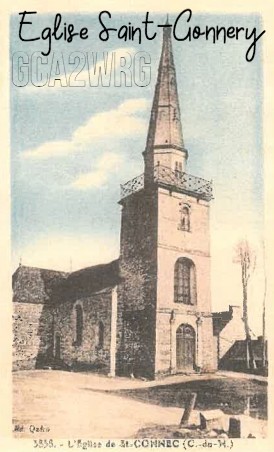
La commune de Saint-Connec est située dans le sud du département des Côtes-d'Armor, en Argoat, à la limite avec le département du Morbihan. Saint-Connec est, à l'origine, un démembrement de l'ancienne paroisse primitive de Neuilliac, appartenant aux seigneurs de Mur puis aux Rohan, puisqu'en 1284, Guillaume de Mur vend « sancto Conovo [... ] in parrochia de Mur » au vicomte Josselin de Rohan. Sous l'Ancien Régime, la paroisse de Saint-Connec dépend donc de celle de Mûr-de-Bretagne en tant que succursale, et appartient au diocèse de Quimper.
The commune of Saint-Connec is located in the south of the department of Côtes-d'Armor, in Argoat, on the border with the department of Morbihan. Saint-Connec is, originally, a dismemberment of the old primitive parish of Neuilliac, belonging to the lords of Mur and then to the Rohan family, since in 1284, Guillaume de Mur sells "sancto Conovo [...] in parrochia de Mur" to the viscount Josselin de Rohan. Under the Old Regime, the parish of Saint-Connec thus depends on that of Mûr-de-Bretagne as a branch, and belongs to the diocese of Quimper.
L'église Saint-Gonnery / The church of Saint-Gonnery
Cette église est la paroissiale primitive de Saint-Connec, bâtie sur un plan en croix latine. La première pierre est posée le 25 mars 1784. Puis c'est la tour qui voit sa construction débuter en 1786 (date portée) et se terminer le 25 novembre 1787, date à laquelle la croix qui la surmonte est bénite. Enfin, il faut attendre le 15 juillet 1788 pour que l'évêque de Quimper, monseigneur Toussaints de Saint-Luc, se déplace afin de bénir l'église.
This church is the primitive parish church of Saint-Connec, built on a Latin cross plan. The first stone was laid on March 25, 1784. Then the construction of the tower began in 1786 (date given) and was completed on November 25, 1787, the date on which the cross on top of it was blessed. Finally, it was not until July 15, 1788 that the bishop of Quimper, Monsignor Toussaints de Saint-Luc, came to bless the church.
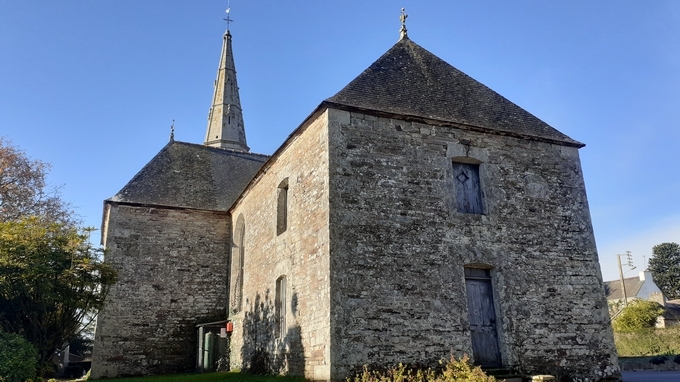
Bâtie en schiste, l'église possède des jambages, chaînages d'angle et une façade ouest en granit. Excepté quelques reprises en ciment, toute la maçonnerie de l'église est liée au mortier de terre. On remarque également les traces d'outil encore bien visibles sur les pierres, notamment les schistes de la façade sud.
Built in schist, the church has jambs, corner quoins and a western facade in granite. Except for some cement repairs, all the masonry of the church is bound with earth mortar. One can also see the traces of tools still visible on the stones, especially the schist of the south façade.
La géologie (simplifiée) de Bretagne / The (simplified) geology of Brittany
Les roches du sous-sol breton ne sont pas les mêmes partout : gneiss, granite, schiste, etc. Elles se sont formées de plusieurs manières et à différentes époques. Les chercheurs s’intéressent à elles pour comprendre et écrire l’histoire géologique de la Bretagne, de notre planète.
- micaschiste / formé dans le sous-sol par transformation d’une roche pré-existante (ex : schiste).
- gneiss / formé dans le sous-sol par transformation d’une roche pré-existante (ex : schiste ou granite).
- ophiolites / roches d’un plancher océanique charriées sur le continent lors d’une collision
- granite / formé par le refroidissement lent d’un magma (roche fondue) en profondeur dans le sous-sol.
- schiste et grès / formés par des dépôts de sable (grès) et de vase (schiste) en millieu marin.
- basalte et rhyolite / formés par le refroidissement d’une lave issue d’un volcan.
- sable / formé par l’usure de roches pré-existantes et de débris d’organismes vivants.
The rocks of the Breton subsoil are not the same everywhere: gneiss, granite, schist, etc.. They were formed in different ways and at different times. Researchers are interested in them to understand and write the geological history of Brittany, of our planet.
- micaschist / formed in the subsoil by transformation of a pre-existing rock (e.g. schist).
- gneiss / formed in the subsoil by transformation of a pre-existing rock (e.g. schist or granite).
- ophiolites / rocks of an ocean floor carried on the continent during a collision
- granite / formed by the slow cooling of a magma (molten rock) deep underground.
- shale and sandstone / formed by deposits of sand (sandstone) and mud (shale) in a marine environment.
- basalt and rhyolite / formed by the cooling of lava from a volcano.
- sand / formed by the wear of pre-existing rocks and debris of living organisms.

L’histoire géologique de la Bretagne débute il y a 2000 millions d’années (2000 Ma), âge des plus anciennes roches de Bretagne (et de France). Les scientifiques écrivent cette histoire en plusieurs chapitres. Parmi les principales roches qui constituent la Bretagne, certaines comme les schistes et le grès se sont formées dans des océans par l’accumulation de sédiments (sable, vase, etc.)
The geological history of Brittany begins 2000 million years ago (2000 Ma), age of the oldest rocks in Brittany (and France). Scientists write this history in several chapters. Among the main rocks that constitute Brittany, some like shales and sandstone were formed in oceans by the accumulation of sediments (sand, mud, etc.)
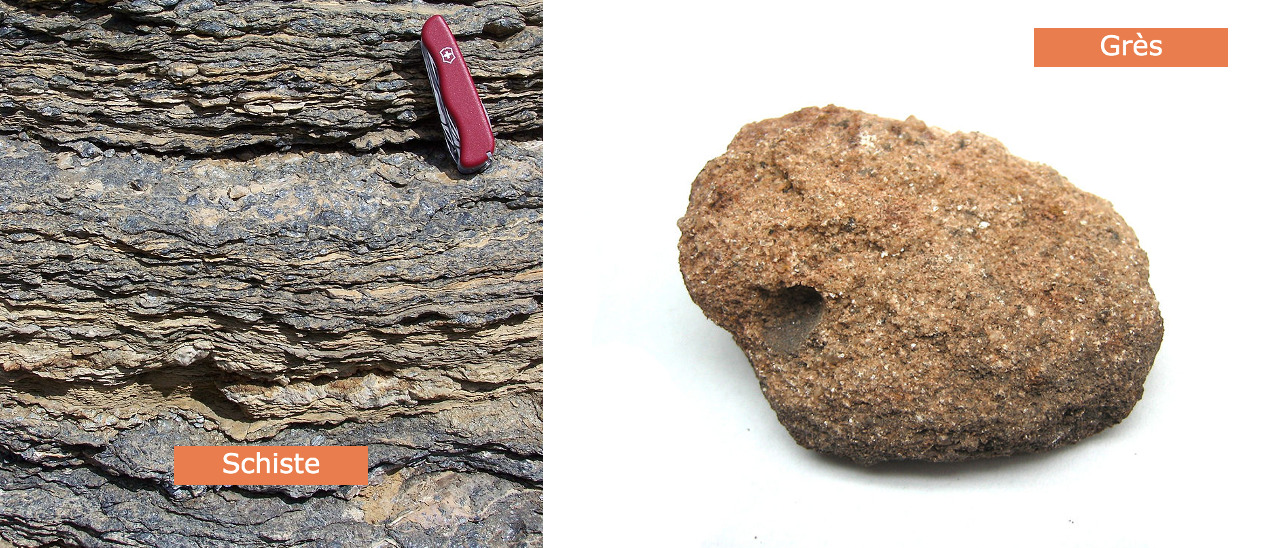
Le schiste est une roche d'origine sédimentaire ou métamorphique formée à partir d'argile. La roche présente une structure feuilletée. Le dépôt d'argile se fait dans des eaux calmes. Le schiste se forme sous l'effet de fortes pressions qui s'exercent sur les argiles pendant les mouvements de plissement des montagnes. De son côté, toujours en profondeur, le sable qui est soumis à une forte pression se solidifie : il devient une autre roche, compacte, le grès.
Schist is a rock of sedimentary or metamorphic origin formed from clay. The rock has a laminated structure. The clay is deposited in calm waters. The schist is formed under the effect of strong pressures which are exerted on the clays during the movements of folding of the mountains. On its side, always in depth, the sand which is subjected to a strong pressure solidifies: it becomes another rock, compact, the sandstone.
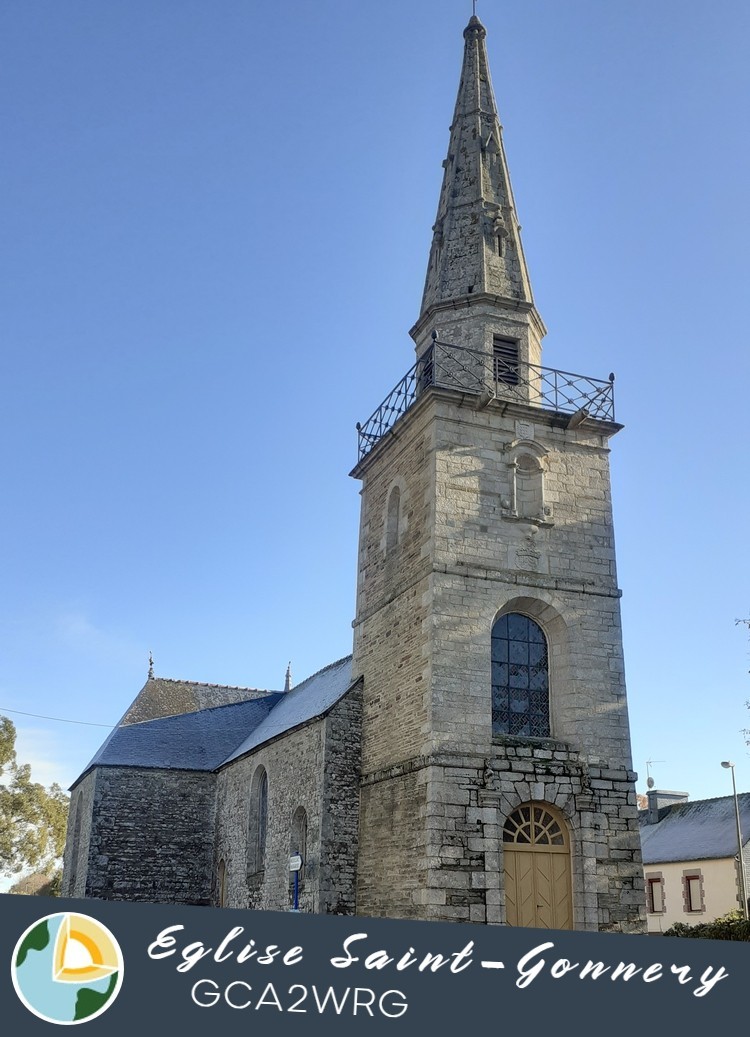
Si vous avez la possibilité de rentrer dans l'église n'oubliez pas d'observer le narthex (situé au seuil d'une église, le narthex est une sorte de vestibule par lequel on pénètre juste avant d'entrer dans la nef) qui constitue la base de la tour-clocher et qui se compose de deux espaces séparés d'une petite marche en moellons de schiste liées au mortier de terre, couronnés d'une large plaque schisteuse. A l'intérieur des dalles de schiste rejointoyées au ciment couvrent le sol, l'une d'entre elle est gravée avec 2 anges et une croix ...
If you have the opportunity to enter the church, don't forget to observe the narthex (located at the threshold of a church, the narthex is a kind of vestibule through which one enters just before entering the nave) which constitutes the base of the bell-tower and which is composed of two spaces separated by a small step made of shale rubble bound with earth mortar, crowned with a large shale slab. Inside, slabs of schist repointed with cement cover the floor, one of them is engraved with 2 angels and a cross ...
Observations de l'extérieur / Observations from the outside
Pour faciliter la découverte des particularité géologique de cette église, les observations ainsi que la photo que vous avez à faire sont à l'extérieur. Dans un premier temps prenez-vous en photo (vous ou votre objet Geocaching fétiche, votre pseudo sur un bout de papier ou sur votre main) devant la porte d'entrée de l'église. Vous ajouterez cette photo à votre log de découverte.
To facilitate the discovery of the geological particularities of this church, the observations as well as the photo you have to take are outside. First, take a picture of yourself (you or your favorite Geocaching object, your nickname on a piece of paper or on your hand) in front of the church entrance. You will add this picture to your discovery log.
Ensuite rendez-vous aux coordonnées de cette earthcache, vous êtes devant la façade Nord de l'église. Observez les roches situées au-dessus du point de nivellement (voir photo ci-dessous).
Then go to the coordinates of this earthcache, you are in front of the north façade of the church. Observe the rocks located above the leveling point (see photo below).
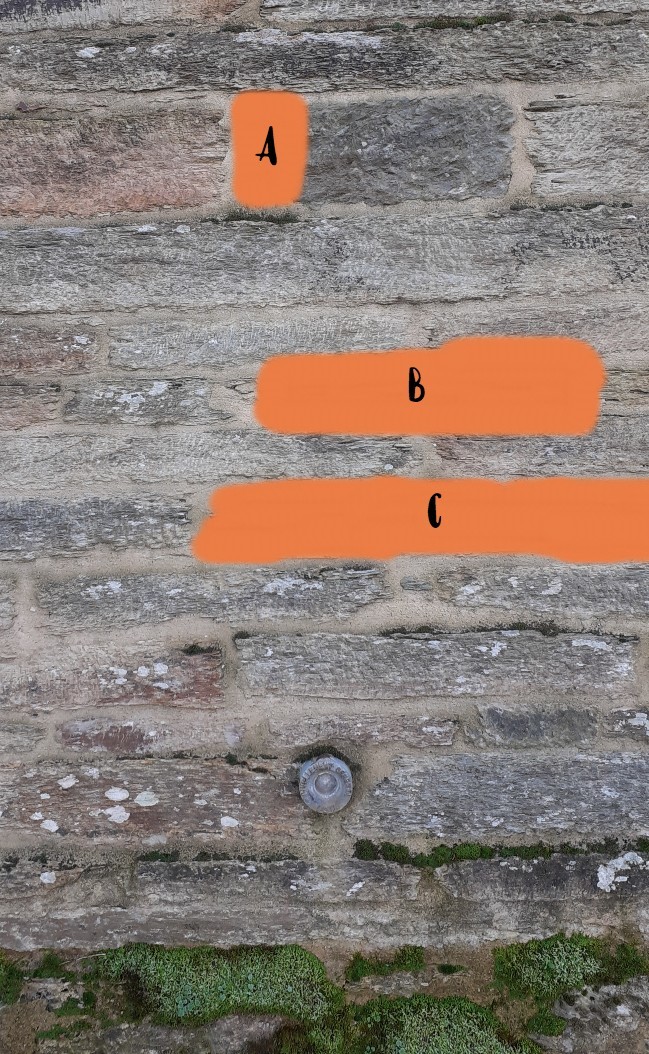
Question 1 - Quel aspect et couleur ont les roches situées sous les zones A, B et C ? Est-ce du schiste ou du grès ? Dans quel sens (vertical ou horizontal) se trouve la roche ?
Question 1 - What is the appearance and color of the rocks underneath the A, B and C zones? Is it shale or sandstone? In which direction (vertical or horizontal) is the rock located?
Rendez-vous maintenant au waypoint n°2 (N 48° 10.629' W 2° 55.247') de l'autre côté de l'église. Observez les roches située au-dessus de l'éventail en terre cuite.
Now go to waypoint n°2 (N 48° 10.629' W 2° 55.247') on the other side of the church. Observe the rocks above the terracotta fan.

Question 2 - Quel aspect et couleur ont les roches situées sous les zones D et E ? Est-ce du schiste ou du grès ? Dans quel sens (vertical ou horizontal) se trouve la roche ?
Question 2 - What is the appearance and color of the rocks below zones D and E? Is it shale or sandstone? In which direction (vertical or horizontal) is the rock located?
Pour valider cette earthcache / To validate this earthcache
Vous pouvez loguer cette cache "Found it" en n'oubliant pas la photo dans votre log (photo obligatoire) et m'envoyer vos réponses aux 2 questions soit via mon profil, soit via la messagerie geocaching.com (Message Center), et je vous contacterai en cas de problèmes dans vos réponses.
Log in this "Found it" cache with your photo in your log and send me your answers either via my profile or via the geocaching.com (Message Center) mail, and I will contact you in case of a problem.
Pour rappel : il n'y a pas de boîte à trouver pour valider une earthcache ! Vous pouvez loguer votre découverte mais devez aussi m'envoyer vos réponses au plus vite.
To remind: there is no box to find to validate an earthcache! You can log your discovery but also send me your answers as soon as possible.
Source : Etude préalable à la restauration de l'église (Frédéric le Bec, architecte du Patrimoine - Novembre 2015) / La géologie bretonne expliqué aux plus jeunes - Maison des Mineraux / Vikidia, l'encyclopedie des 8 - 13 ans / Le schiste sur Wikipedia.
Communes sans geocaches en Bretagne
Cette geocache a été posée dans le cadre du projet Plus une communes sans géocaches en Bretagne porté par l'association des Breizh Geocacheurs.
